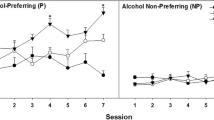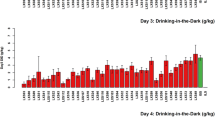Abstract
C57BL/6J × FVB/NJ F1 (B6 × FVB) mice consume more alcohol than C57BL/6J × NZB/B1NJ F1 (B6 × NZB) mice and this high alcohol consumption is stable after abstinence whereas B6 × NZB show reduced consumption, thus providing models of Sustained Alcohol Preference (SAP) and Reduced Alcohol Preference (RAP). In female hybrids, we assessed several behavioral responses to define behaviors which might predict SAP and RAP. B6 × FVB exhibited less severe ethanol-induced conditioned taste aversion and were less sensitive to ethanol-induced loss of righting reflex than B6 × NZB. Both hybrids demonstrated ethanol-induced place preference and a low ethanol withdrawal severity. We found that these hybrids differ in their sensitivity to the aversive and sedative, but not rewarding, effects of ethanol. Results of elevated plus maze, mirror chamber, and locomotor tests reveal B6 × FVB mice are less anxious and more active than B6 × NZB mice. Results obtained offer insights about factors that determine SAP and RAP in these new genetic models of alcohol consumption.







Similar content being viewed by others
References
Bachmanov AA, Kiefer SW, Molina JC, Tordoff MG, Duffy VB, Bartoshuk LM, Mennella JA (2003) Chemosensory factors influencing alcohol perception, preferences, and consumption. Alcohol Clin Exp Res 27:220–231
Belknap JK, Crabbe JC, Young ER (1993) Voluntary consumption of ethanol in 15 inbred mouse strains. Psychopharmacology 112:503–510
Blednov YA, Stoffel M, Chang SR, Harris RA (2001) Potassium channels as targets for ethanol: studies of G-protein-coupled inwardly rectifying potassium channel 2 (GIRK2) null mutant mice. J Pharmacol Exp Ther 298:521–530
Blednov YA, Stoffel M, Cooper R, Wallace D, Mane N, Harris RA (2002) Hyperactivity and dopamine D1 receptor activation in mice lacking girk2 channels. Psychopharmacology 159:370–378
Blednov YA, Walker D, Osterndorf-Kahanek E, Harris RA (2004) Mice lacking metabotropic glutamate receptor 4 do not show the motor stimulatory effect of ethanol. Alcohol 34:251–259
Blednov YA, Metten P, Finn DA, Rhodes JS, Bergeson SE, Harris RA, Crabbe JC (2005) Hybrid C57BL/6J × FVB/NJ mice drink more alcohol than do C57BL/6J mice. Alcohol Clin Exp Res 29:1949–1958
Blednov YA, Walker D, Martinez M, Harris RA (2006) Reduced alcohol consumption in mice lacking preprodynorphin. Alcohol 40:73–86
Blednov YA, Cravatt BF, Boehm SL II, Walker D, Harris RA (2007a) Role of endocannabinoids in alcohol consumption and intoxication: studies of mice lacking fatty acid amide hydrolase. Neuropsychopharmacology 32:1570–1582
Blednov YA, Walker D, Martinez M, Levine M, Damak S, Margolskee RF (2007b) Perception of sweet taste is important for voluntary alcohol consumption in mice. Genes Brain Behav 7:1–13
Blednov YA, Ozburn AR, Walker D, Ahmed S, Belknap JK, Harris RA (2010) Hybrid mice as genetic models of high alcohol consumption. Behav Genet 40:93–110
Broadbent J, Muccino KJ, Cunningham CL (2002) Ethanol-induced conditioned taste aversion in 15 inbred mouse strains. Behav Neurosci 116:138–148
Chester JA, Lumeng L, Li TK, Grahame NJ (2003) High- and low-alcohol-preferring mice show differences in conditioned taste aversion to alcohol. Alcohol Clin Exp Res 27:12–18
Crabbe JC, Merrill C, Belknap JK (1991) Acute dependence on depressant drugs is determined by common genes in mice. J Pharmacol Exp Ther 257:663–667
Cunningham CL, Gremel CM, Groblewski PA (2006) Drug-induced conditioned place preference and aversion in mice. Nat Protoc 1:1662–1670
Dixon WJ (1965) The up and down method for small samples. J Am Stat Assoc 60:967–978
Fergusson DM, Boden JM, Horwood LJ (2008) The developmental antecedents of illicit drug use: evidence from a 25-year longitudinal study. Drug Alcohol Depend 96:165–177
Fernández-Teruel A, Driscoll P, Gil L, Aguilar R, Tobeña A, Escorihuela RM (2002) Enduring effects of environmental enrichment on novelty seeking, saccharin and ethanol intake in two rat lines (RHA/Verh and RLA/Verh) differing in incentive-seeking behavior. Pharmacol Biochem Behav 73:225–231
Grahame NJ, Rodd-Henricks K, Li TK, Lumeng L (2000) Ethanol locomotor sensitization, but not tolerance correlates with selection for alcohol preference in high- and low-alcohol preferring mice. Psychopharmacology 151:252–260
Green AS, Grahame NJ (2008) Ethanol drinking in rodents: is free-choice drinking related to the reinforcing effects of ethanol? Alcohol 42:1–11
Heilig M, Koob GF (2007) A key role for corticotropin-releasing factor in alcohol dependence. Trends Neurosci 30:399–406
Hill KG, Alva H, Blednov YA, Cunningham CL (2003) Reduced ethanol-induced conditioned taste aversion and conditioned place preference in GIRK2 null mutant mice. Psychopharmacology 169:108–114
Kalivas PW, Pierce RC, Cornish J, Sorg BA (1998) A role for sensitization in craving and relapse in cocaine addiction. J Psychopharmacol 12:49–53
Kiefer SW, Hill KG, Kaczmarek HJ (1998) Taste reactivity to alcohol and basic tastes in outbred mice. Alcohol Clin Exp Res 22:1146–1151
Kliethermes CL, Finn DA, Crabbe JC (2003) Validation of a modified mirrored chamber sensitive to anxiolytics and anxiogenics in mice. Psychopharmacology 169:190–197
Lessov CN, Phillips TJ (1998) Duration of sensitization to the locomotor stimulant effects of ethanol in mice. Psychopharmacology 135:374–382
Lessov CN, Palmer AA, Quick EA, Phillips TJ (2001) Voluntary ethanol drinking in C57BL/6J and DBA/2J mice before and after sensitization to the locomotor stimulant effects of ethanol. Psychopharmacology 155:91–99
Lister RG (1987) The use of a plus-maze to measure anxiety in the mouse. Psychopharmacology 92:180–185
Liu C, Showalter J, Grigson PS (2009) Ethanol-induced conditioned taste avoidance: reward or aversion? Alcohol Clin Exp Res 33:522–530
Lundquist F (1959) The determination of ethyl alcohol in blood and tissue. Methods Biochem Anal 7:217–251
McMillen BA, Williams HL (1998) Role of taste and calories in the selection of ethanol by C57BL/6NHsd and Hsd:ICR mice. Alcohol 15:193–198
Metten P, Phillips TJ, Crabbe JC, Tarantino LM, McClearn GE, Plomin R, Erwin VG, Belknap JK (1998) High genetic susceptibility to ethanol withdrawal predicts low ethanol consumption. Mamm Genome 9:983–990
Phillips TJ, Huson M, Gwiazdon C, Burkhart-Kasch S, Shen EH (1995) Effects of acute and repeated ethanol exposures on the locomotor activity of BXD recombinant inbred mice. Alcohol Clin Exp Res 19:269–278
Phillips TJ, Broadbent J, Burkhart-Kasch S, Henderson C, Wenger CD, McMullin C, McKinnon CS, Cunningham CL (2005) Genetic correlational analyses of ethanol reward and aversion phenotypes in short-term selected mouse lines bred for ethanol drinking or ethanol-induced conditioned taste aversion. Behav Neurosci 119:892–910
Risinger FO, Cunningham CL (1998) Ethanol-induced conditioned taste aversion in BXD recombinant inbred mice. Alcohol Clin Exp Res 22:1234–1244
Robinson TE, Berridge KC (2000) The psychology and neurobiology of addiction: an incentive-sensitization view. Addiction 95:S91–S117
Rodgers RJ, Johnson NJ (1995) Factor analysis of spatiotemporal and ethological measures in the murine elevated plus-maze test of anxiety. Pharmacol Biochem Behav 52:297–303
Rodgers DA, McClearn GE (1962) Mouse strain differences in preference for various concentrations of alcohol. Q J Stud Alcohol 23:26–33
Seale TW, Niekrasz I, Garrett KM (1996) Anxiolytics by ethanol, diazepam and buspirone in a novel murine behavioral assay. Neuroreport 7:1803–1808
Toubas PL, Abla KA, Cao W, Logan LG, Seale TW (1990) Latency to enter a mirrored chamber: a novel behavioral assay for anxiolytic agents. Pharmacol Biochem Behav 35(1):121–126
Tzschentke TM (2007) Measuring reward with the conditioned place preference (CPP) paradigm: update of the last decade. Addict Biol 12:227–462
Ufer M, Dadmarz M, Vogel WH (1999) Voluntary consumption of amphetamine, cocaine, ethanol and morphine by rats as influenced by a preceding period of forced drug intake and clozapine. Pharmacology 58:285–291
Yoneyama N, Crabbe JC, Ford MM, Murillo A, Finn DA (2008) Voluntary ethanol consumption in 22 inbred mouse strains. Alcohol 42:149–160
Acknowledgments
We would like to thank Igor Ponomarev for many helpful discussions and Marni Martinez, Jennifer Stokes, and Danielle Walker for assistance in animal husbandry and data collection. This research was supported by the Integrative Neuroscience Initiative on Alcoholism Consortium Grant AA13520, and National Institute on Alcohol Abuse and Alcoholism Grants AA06399-S and AA16424.
Author information
Authors and Affiliations
Corresponding author
Additional information
Edited by Stephen Maxson.
Rights and permissions
About this article
Cite this article
Ozburn, A.R., Harris, R.A. & Blednov, Y.A. Behavioral Differences Between C57BL/6J × FVB/NJ and C57BL/6J × NZB/B1NJ F1 Hybrid Mice: Relation to Control of Ethanol Intake. Behav Genet 40, 551–563 (2010). https://doi.org/10.1007/s10519-010-9357-x
Received:
Accepted:
Published:
Issue Date:
DOI: https://doi.org/10.1007/s10519-010-9357-x




